New Years Resolutions: The Bridge on the River Kwai (1957)
- Samantha Glasser

- Jan 3
- 7 min read
January is for New Year’s Resolutions, and your Picture Show bloggers have resolved to watch more award-winning classic films.
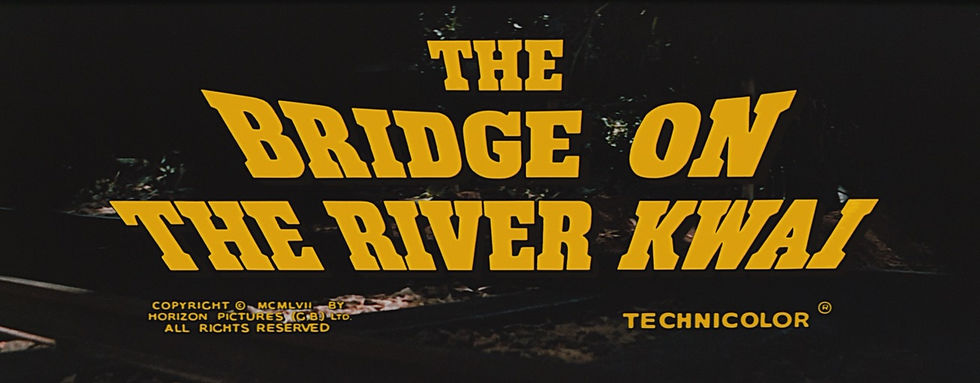
RODNEY BOWCOCK: Likely, the films that we are covering this month are films that need no
introduction to our readers, but as I stated a few weeks back, while I have seen all of the Blondie and Jungle Jim films, my knowledge of many of the warhorses of classic cinema is seriously lacking. So I find myself sitting down for nearly three hours to see if The Bridge on the River Kwai is worth the hoopla (and also worth the seven Oscars that it picked up).
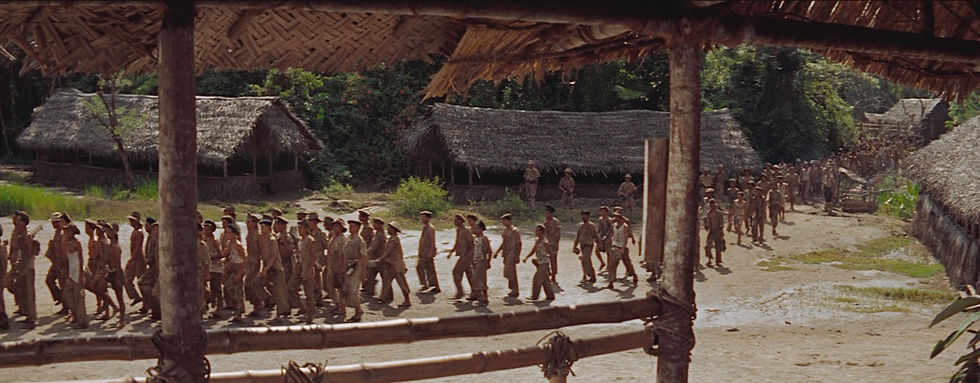
SAMANTHA GLASSER: I, of course, was aware of this movie, the whistling soldiers marching and building a bridge. That was the extent of my knowledge other than the casting of Alec Guinness. Seeing William Holden surprised me because I had no idea he was in this movie, and it was fun to see Sessue Hayakawa, who I knew exclusively as a silent movie actor, in a later role. Hayakawa was 68, and memorizing the long speeches was difficult. He assumed the lines he spoke during Guinness's reactions could be dubbed, so he failed to memorize those lines. Director David Lean told him it was unacceptable and gave him a day to learn all of his lines, taking close-ups and filler shots to utilize the time. One scene took 26 takes for Hayakawa to get it right, and then Guinness wasn't satisfied with his own performance and asked to do it again.

RB: The plot of the film is seemingly simple but is one that likely lends itself to additional thought and scrutiny. It centers upon a group of British soldiers that are captured and sent to a Japanese prison camp in Thailand. In spite of the horrific conditions of the camp, escape likely provides an even worse fate due to the remote location of the camp. Colonel Nicholson (Guinness) orders those under his outfit not to escape, but a few do attempt to. Only one survives.
The prisoners are ordered to build a bridge across the river (hence the title…), but the work on it is slow and incompetent until Nicholson orders a proper bridge to be designed and built. There is some conflict regarding if this bridge will be a tribute to British engineering, or if this is essentially conspiring the with the enemy. That said, the bridge gets built.
Meanwhile, Commander Shears (Holden) the escapee who managed to escape, has been recruited to be part of a unit assigned to destroy the bridge (as they don’t know that the British military built the bridge from the ground up). Tension builds as two forces on the same side unknowingly work against each other.
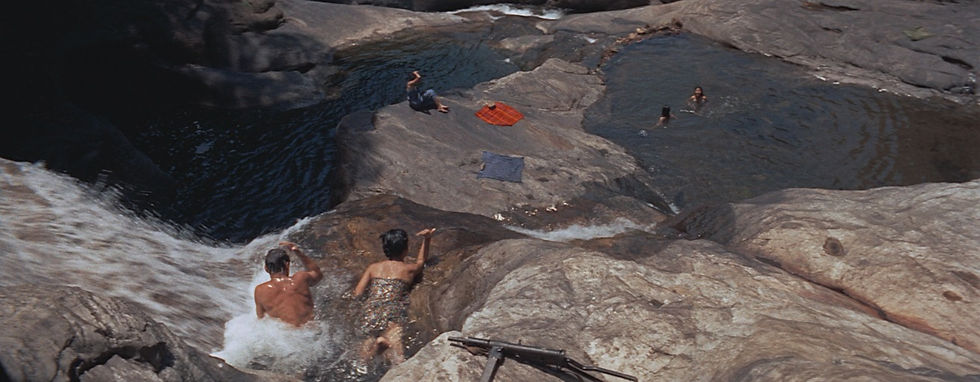
SG: Lean is closely associated with grand visuals and impressive wide shots. His artistic composition can be seen throughout this film too. First, he impresses upon the viewer the rigidity of the English military in the way they arrive at the prison camp, and the amount of people suddenly thrust upon the Japanese leadership in contrast with the many graves on site. The amount of dirt and desolation there shows how unbearable it is for the prisoners, and it is a wonder anyone survived those punishment boxes. As the film continues, we see areas of wilderness on the island that are vibrant with cool water and life. The bathing pools are lush and inviting, like something out of a vacation brochure. The shots of the bats swirling overhead were lovely. These are contrasted with the violence and ridiculousness of war as bloodshed encroaches, or as the soldiers slash their way through the brush to reach their destination.
The costume (John Apperson) and makeup department (Stuart Freeborn, George Partleton) did an excellent job of making Holden look weathered and dirty.
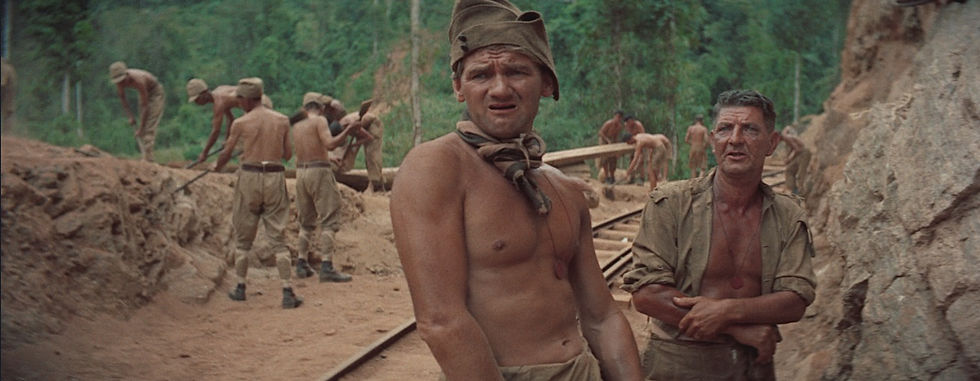
Casting was not simple for this film. Cary Grant, Lawrence Olivier, Noel Coward, Spencer Tracy and Charles Laughton were all considered for roles. Guinness waffled on whether he wanted to play the part. Jack Hawkins claimed he pressured him to do it, having worked with him previously on stage and in The Prisoner. "I couldn't believe in Colonel Nicholson," Guinness said. "I thought he was such a humorless ass that it would turn out to be dull, but Spiegel persuaded me otherwise. The book I had read and enjoyed. I thought it rather disturbingly anti-British, but it was interesting, and the final script was a good script."
RB: Reports in the trades regarding the making of the film go back to 1956, with Humphrey Bogart
being considered for the lead. Orson Welles was also offered a starring role. This was a big picture by any studio’s standards, but according to Lean, it still didn’t stop the inherit racism and misogyny of the time from rearing its head. Columbia was concerned about the lack of white women in the film, which caused Lean to add in a peculiar, out of place and brief romantic subplot, that, frankly, makes no sense.
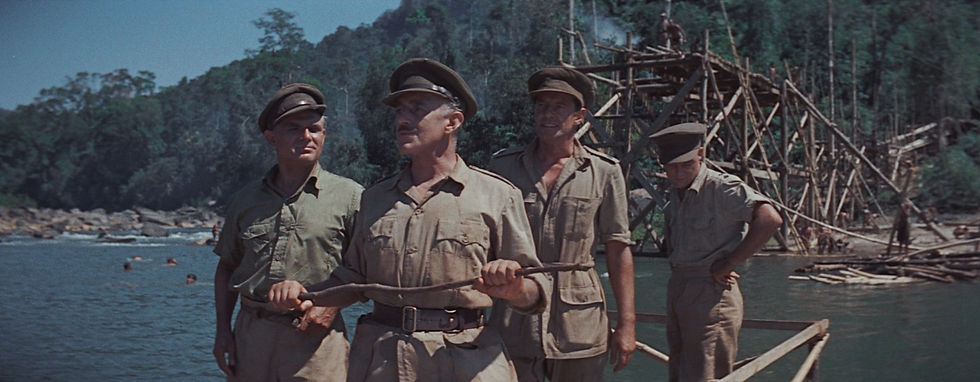
SG: The film has a scene that seems to scream out the message the way some films drop their titles into the dialogue. It was a powerful point well played, but it felt too obvious to me. "Destroy a bridge or destroy yourself. This is just a game, this war... For what? How to die like a gentleman, how to die by the rules, when the only important thing is how to live like a human being." The script went through many different writers to capture the message and sentiment of the novel by Pierre Boulle. Carl Foreman, who was a blacklisted writer, was one of them, who said, "You can't take up three minutes with British troops walking into a camp whistling a tune nobody's ever heard of-- you can't expect people to sit in their seats. It won't hold."
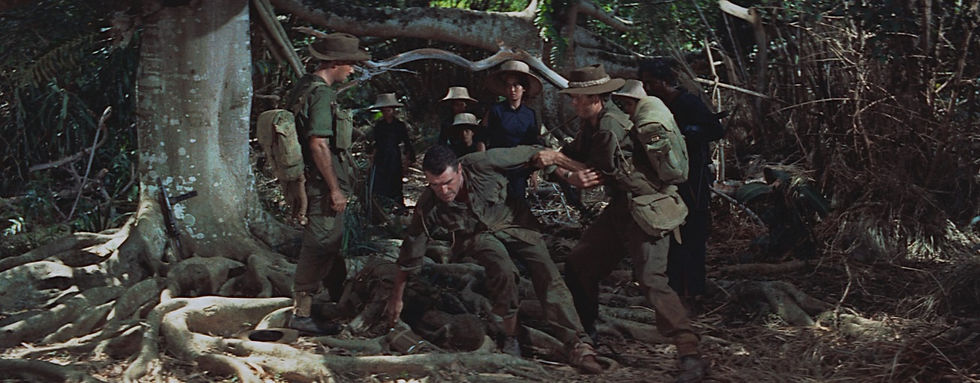
It was a difficult shoot. There was a strike during the shoot, the weather was miserably hot, and there was tension between Lean and the British cast. There were also a few deaths. Lean almost drowned during a recreational swim on a day off until Geoffrey Horne (Joyce) rescued him. A stuntman died after almost drowning during a fall from the bridge. He ingested a parasite in the water and died from the effects. Another crew member died after a car accident on a jungle road.
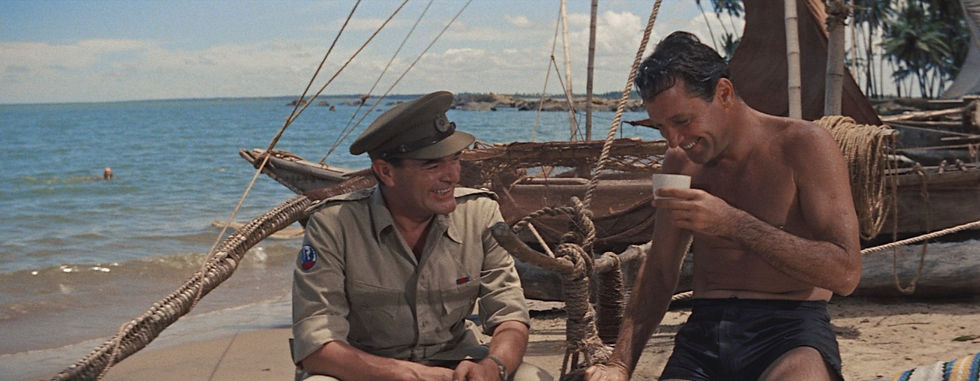
Not all of the behind-the-scenes stories were unpleasant. Hawkins said, "I loved working on this film because it was almost entirely shot in Ceylon [Sri Lanka], which is a country to which I am devoted. In fact, it was largely because of me that this location was chosen." Hawkins had spent time there during the war. However, according to Kevin Brownlow's book on David Lean, the location was chosen by art director Don Ashton because of his own war experience there. Guinness spent his free time fishing, though he never caught anything. Holden loved fireworks and went to the local market to buy Roman candles and fire balloons for evening displays. After one launch, a fire balloon began drifting toward the bridge set, causing Speigel to panic. He jumped into his jeep and raced to the set, but luckily the fireworks fell into the river before hitting the bridge.
RB: While the book that the film was based on is basically fiction, the plot is rooted in fact. There was a Burma-Siam railway that was largely built by prisoners of war and forced labor from Malaya, Siam and Burma. Some reports state that over 100,000 people died during the making of the bridge. It’s a troubling thought to consider that so many people died in the creation of something that never would’ve benefitted them at all.
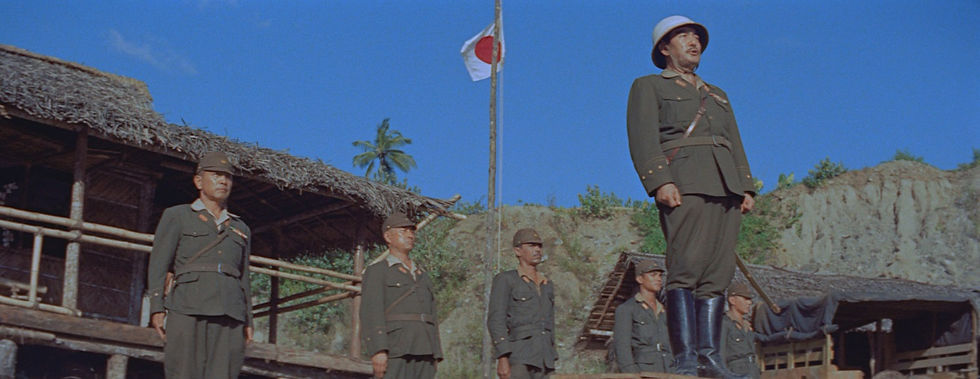
SG: The set bridge was built in 9 months, mostly by beasts of burden. Several of the cast and crew noted their awe of the elephants. "...I think some of my happiest off-duty hours were spent watching elephants as they worked on the building of the bridge," wrote Hawkins. "They were mainly female elephants, and seemed to have some kind of trade union of their own, because about every four hours, just as though someone had blown a whistle, they would drop whatever they were carrying in their trunks and lumber into the river for a long swim and a soak, followed by a good feed. Nothing could persuade them to do otherwise."
Bridge on the River Kwai was a surprise hit, and it was so popular that Mitch Miller made a jazz rendition of "Colonel Bogey." It was a boon for Holden, who took 10% of the profits in addition to his salary.
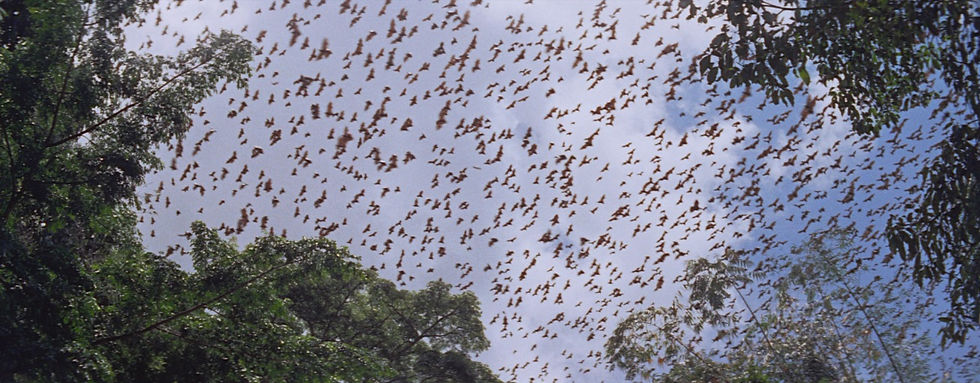
RB: The film was a giant success, both commercially and critically, earning 900% more than the cost of the film. The critics adored it, praising the acting, direction and production. Even the eternal curmudgeon, Bosley Crowther said that the film was “a towering entertainment of rich variety and revelation of the ways of men”. When Crowther likes it, you know you’re seeing something special. As you know, he doesn’t like anything.
So, what’s my take on this? Well, it’s a beautifully shot film and acted in ways that make the proceedings very believable (aside from the hackneyed romantic subplot). The reputation is well earned. I certainly get why it is universally praised and adored. And, yet, there is something that I can’t put my finger on that seems off to me. It’s a film that has stuck with me a lot in the few days since I watched it, both for the execution and the plot, which basically boils down to “War is hell”. Maybe it’s just not my kind of movie, but while it’s a nearly flawless film, it’s not one that I particularly enjoyed watching. Three and a half stars.
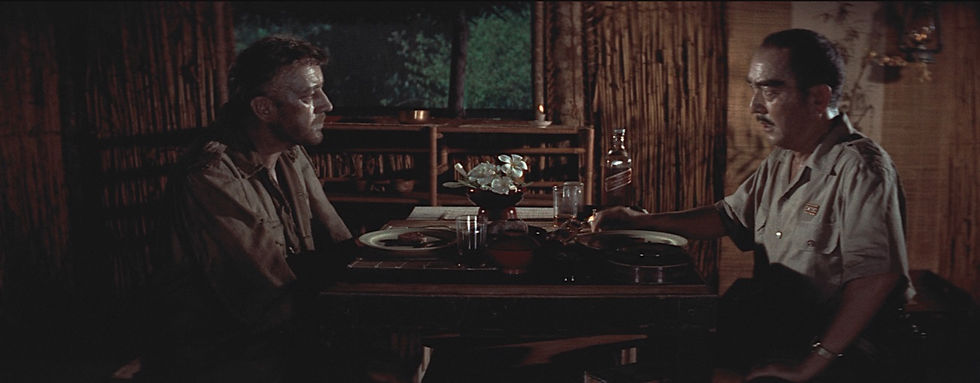
SG: I can appreciate the craftsmanship of this film. Guinness's character was an interesting one; his stiffness and adherence to the rules seemed completely incongruent to the wild and brutal surroundings, so his reaction to the scenario held my interest on a psychological level. The ending was predictable but satisfying. Something just didn't resonate with me personally when I watched. It fell short emotionally. I think there have been other movies with similar messages that have done it better in the years since, weakening the impact of this film. 3.5 stars.




Comments